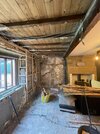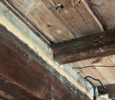Ive just pulled down the cielining in my front room (3 layers of plaster board) as part of a room renovation. I plan to remove all the old electrical cables, secure the heating pipes etc. its an old house and the floor above has always been a bit bouncy. Looking at the 'joists' used they are laughably small. 3x3" and notched to sit on the beams. Its 200 years old is the house so perhaps thats just how they did it, used what they had.
Can anyone suggest a way to sure up the ceiling without coming too far down? the ceiling is quite low as it is.
Can anyone suggest a way to sure up the ceiling without coming too far down? the ceiling is quite low as it is.





